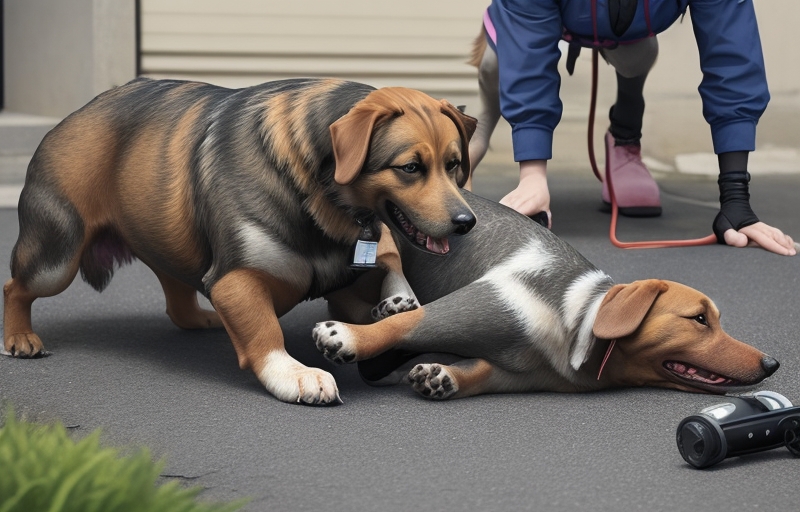Learn about understanding and Preventing Shock in Dogs and discover essential tips to prevent this life-threatening condition. From trauma to allergies, understand the factors that contribute to shock and take proactive measures to safeguard your canine companion’s well-being.
Introduction:
Dogs, like humans, can experience shock, a life-threatening condition that demands immediate attention. Shock in dogs can be caused by various factors, ranging from trauma to underlying health issues. This article aims to delve into the causes of shock in dogs and provide essential tips on preventing this critical condition.
Understanding and Preventing Shock in Dogs
Causes of Shock in Dogs:
Trauma and Injuries:

- Physical injuries, such as accidents or falls, can lead to shock in dogs. Internal bleeding or severe external wounds may cause a rapid drop in blood pressure, triggering shock.
Blood Loss:
- Excessive bleeding due to injury, surgery, or an underlying health problem can result in shock. It’s crucial to monitor your dog for signs of bleeding, especially if they’ve undergone recent medical procedures.
Dehydration:
- Inadequate water intake or illnesses causing excessive fluid loss can lead to dehydration and subsequent shock. This is particularly common in hot climates or in dogs suffering from vomiting or diarrhea.
Severe Infections:
- Untreated infections, such as sepsis or severe systemic diseases, can overwhelm a dog’s immune system, causing shock. Timely veterinary care is essential in managing infections to prevent their progression.
Allergic Reactions:
- Dogs, like humans, can experience severe allergic reactions to certain foods, medications, or insect bites. Anaphylaxis can lead to shock, necessitating immediate intervention.
Heart Conditions:
- Dogs with heart diseases, particularly those affecting the pumping efficiency of the heart, may experience shock due to inadequate blood circulation. Regular veterinary check-ups are crucial for identifying and managing cardiac issues.
Electrocution:
- Dogs are naturally curious creatures, and their exploration may lead them to unsafe areas with electrical hazards. Chewing on electrical cords or coming into contact with faulty wiring can result in electrocution, causing shock. Keep electrical cords out of reach and inspect your home for potential electrical dangers.
Toxic Ingestion:
- Dogs may ingest substances that are toxic to them, leading to severe reactions, including shock. Common toxins include certain plants, human medications, household chemicals, and foods like chocolate, grapes, or onions. Familiarize yourself with potential toxins and keep them securely stored away from your pet.
Heatstroke:
- Dogs are susceptible to heatstroke, especially in hot climates or during intense physical activity. Elevated body temperature can cause multiple organ failure and shock. Avoid strenuous activities during peak temperatures, provide shade, and never leave your dog in a parked car on a warm day.
Blood Clotting Disorders:
- Some dogs may have underlying blood clotting disorders that predispose them to excessive bleeding and shock. These disorders can be genetic or acquired, and early detection through regular veterinary check-ups is crucial for managing and preventing complications.
Here are some alarming facts and figures about shock in dogs:

- Up to 30% of dogs admitted to veterinary intensive care units experience shock.
- The survival rate for dogs in shock can be as low as 50%, depending on the underlying cause and severity.
- Early diagnosis and treatment are crucial for improving a dog’s chances of survival.
Recognizing the signs of shock in your dog is essential:
- Pale gums and tongue
- Weakness and lethargy
- Rapid or shallow breathing
- Cold extremities
- Decreased or absent capillary refill time (press on the gums and see how quickly the color returns)
- Confusion or disorientation
Preventing Shock in Dogs:

Regular Veterinary Check-ups:
- Schedule routine vet visits to monitor your dog’s overall health. Early detection of underlying issues can prevent the development of conditions that might lead to shock.
Safe Environment:
- Create a safe living environment to minimize the risk of accidents and injuries. Secure balconies, remove hazardous items and supervise your dog during outdoor activities.
Proper Nutrition:
- Provide a balanced and nutritious diet to support your dog’s overall health. Consult your veterinarian to determine the best dietary plan for your dog’s specific needs.
Hydration:
- Ensure your dog has access to clean, fresh water at all times, especially during hot weather. Monitor water intake and seek veterinary advice if you notice changes in drinking behavior.
Parasite Control:
- Regularly administer preventive measures against parasites, such as fleas and ticks, to reduce the risk of allergic reactions and infections.
Emergency First Aid:
- Learn basic first aid for dogs, including how to control bleeding and respond to injuries. This knowledge can be invaluable in providing immediate care before reaching the vet.
Conclusion
Understanding the diverse causes of shock in dogs empowers pet owners to take proactive measures, ensuring the well-being and safety of their beloved companions. Regular veterinary care, a safe environment, and prompt action in emergencies play pivotal roles in preventing and managing shock in dogs.
Read Also: Dog in Shock
FAQs:
Q1: How can I tell if my dog is in shock?
Signs of shock in dogs include pale gums, rapid breathing, weak pulse, and lethargy. If you notice these symptoms, seek immediate veterinary attention.
Q2: Can shock in dogs be prevented?
While not all instances can be prevented, maintaining your dog’s overall health through proper nutrition, regular veterinary check-ups and a safe environment can significantly reduce the risk of shock.
Q3: What should I do if my dog is in shock?
If you suspect your dog is in shock, keep them warm, control bleeding if present, and seek emergency veterinary care. Do not delay, as prompt intervention is crucial in such cases.

2 thoughts on “Understanding and Preventing Shock in Dogs: A Comprehensive Guide”